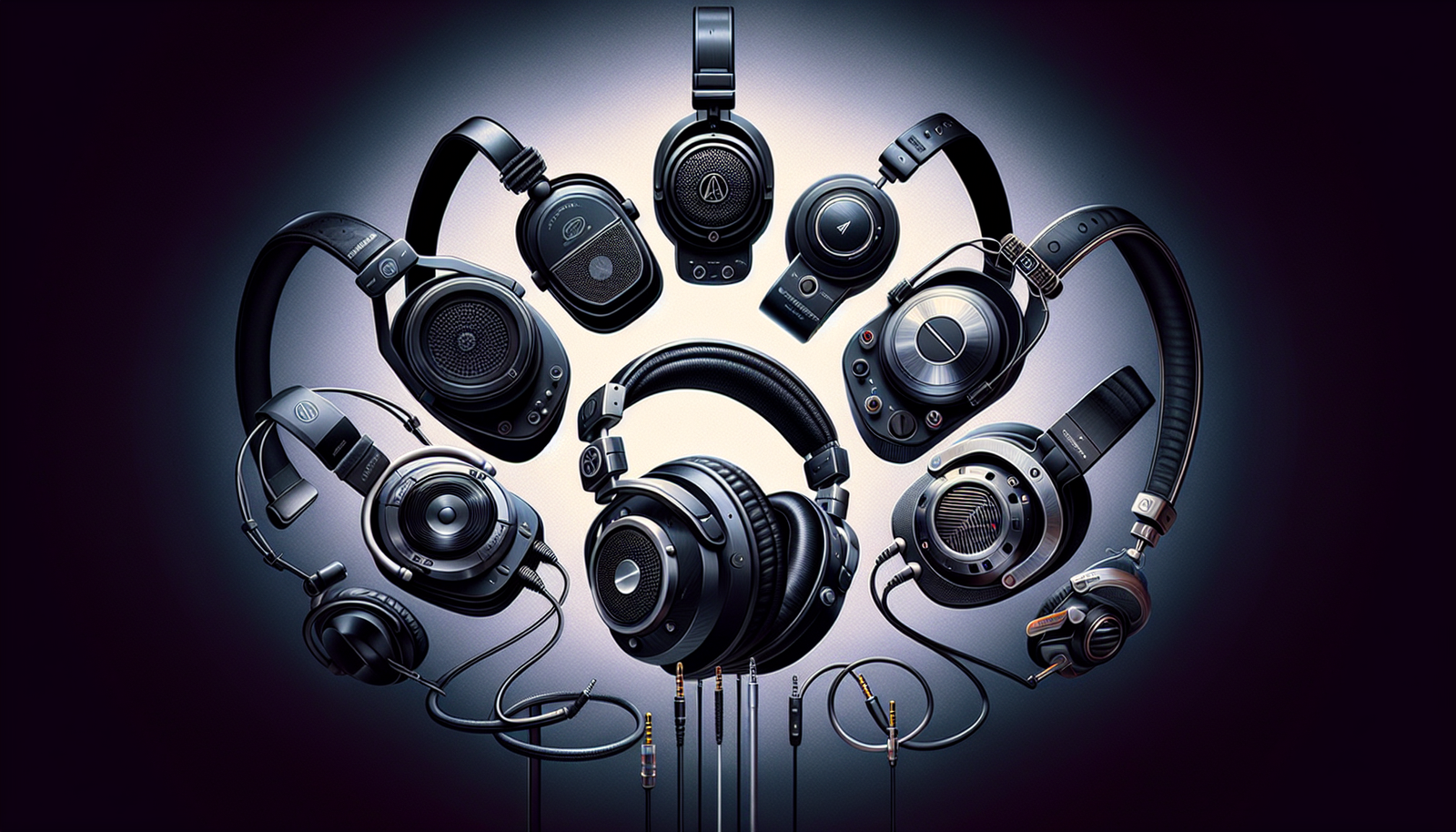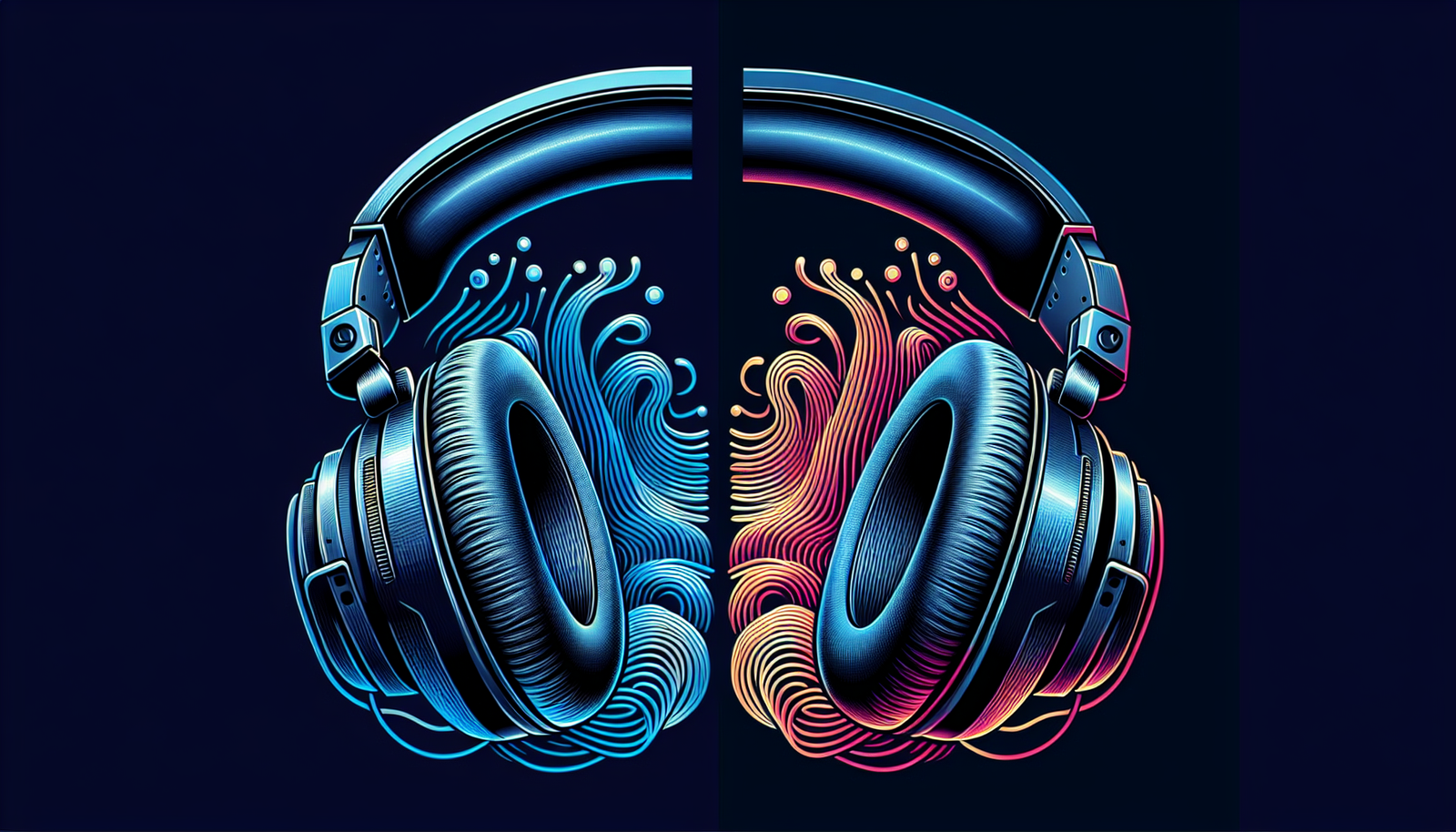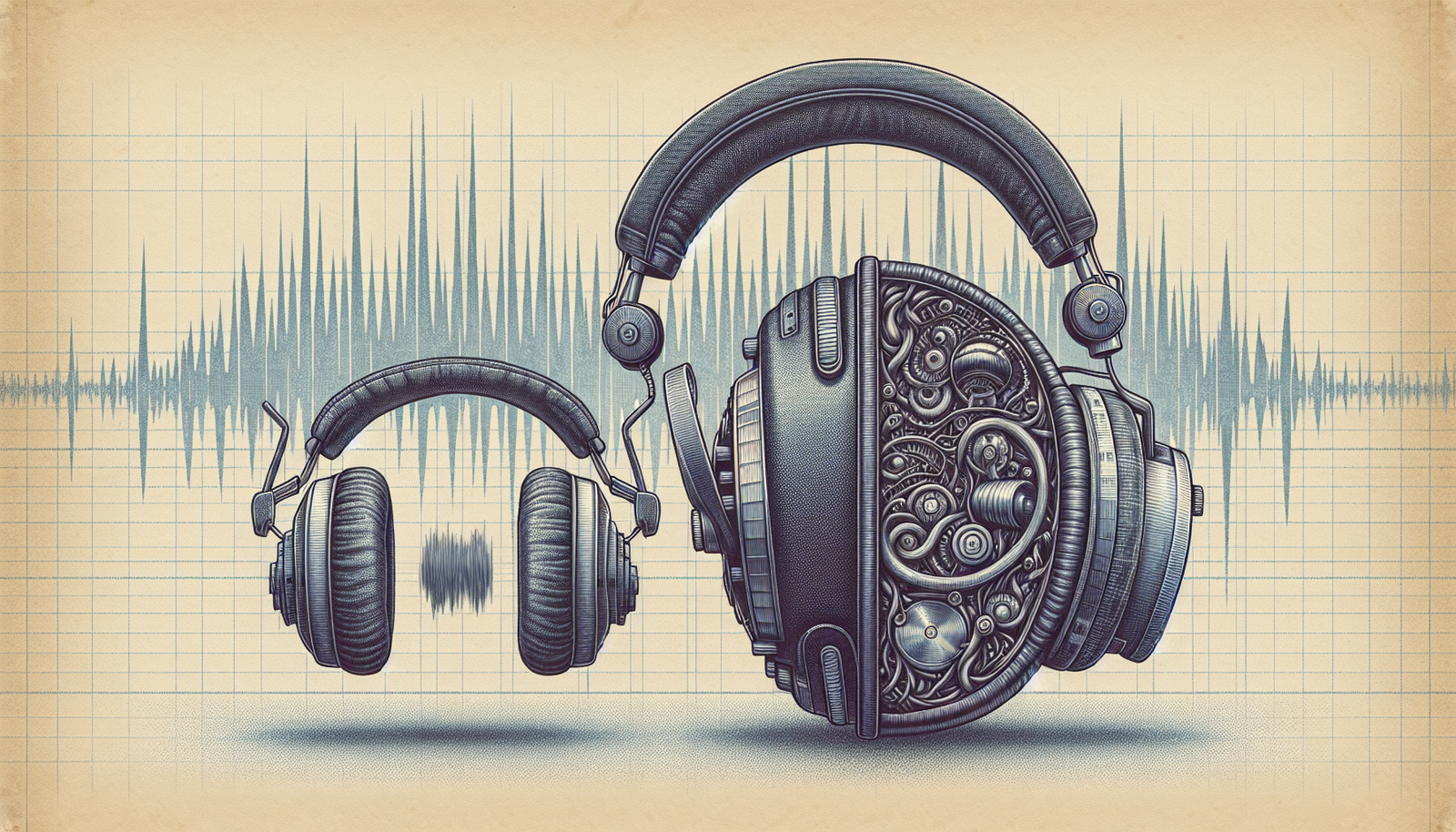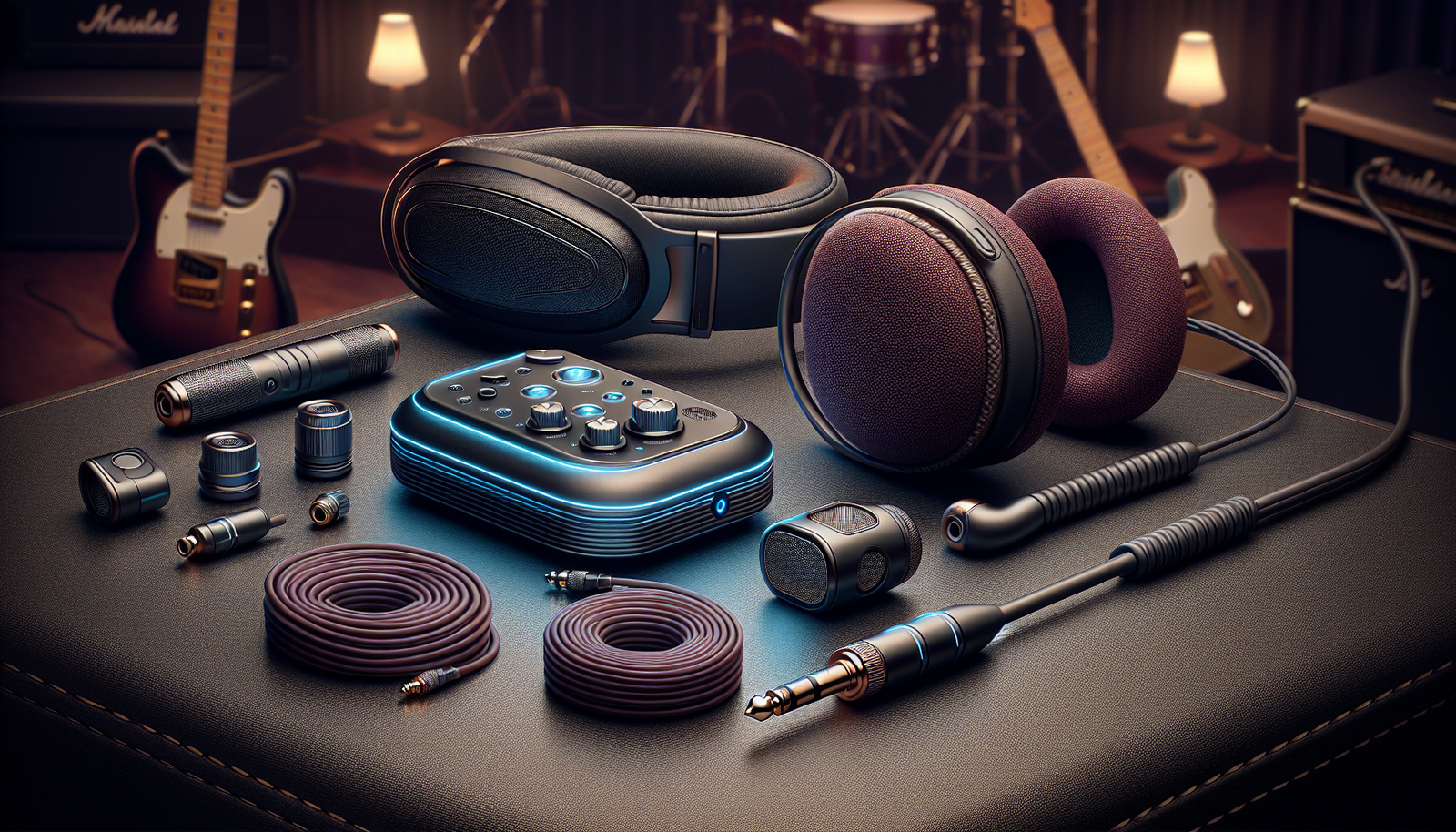Need the best headphones for guitar amp? We’ve got you covered. In this article, expect to find headphones that promise clarity, comfort, and durability. No fluff, just facts to help you get that crystal clear amp sound straight to your ears.
Key Takeaways
- The recommended headphones for guitar amps blend great sound and comfort, with top picks including the Audio Technica ATH-M50x, Boss Waza-Air, Beyerdynamic DT 990 Pro, Sennheiser HD650, and AKG K240 Studio.
- When choosing headphones for guitar amp use, key considerations are sound quality, comfort, noise isolation, and whether to go wired or wireless, with studio headphones often offering the most accurate sound for practice.
- Connectivity and compatibility between headphones and guitar amps are crucial; consider things like impedance, jack sizes, and wireless technology to ensure a seamless playing experience.
Top Headphones for Guitar Amps: Our Recommendations

Headphones designed for the best guitar amp use deliver an impeccable combination of top-notch sound fidelity and comfort, making them ideal partners for engrossing guitar sessions. From intense metal riffs to tranquil chord progressions, these headphones enhance your practice by providing a superior audio experience.
In our selection, we’ve gathered only the finest options available in the realm of guitar amps – each pair exemplifying excellence in delivering outstanding sound quality alongside a comfortable fit that keeps you immersed without any discomfort.
Audio-Technica ATH-M50x
Leading the pack in studio headphone excellence, the Audio Technica ATH-M50x stands out as a favorite among musicians for its outstanding performance. These headphones deliver high-quality audio across various musical styles and do so with affordability that lets you keep hold of your precious instruments—priced at roughly $149, they offer an ideal balance between expense and acoustic fidelity.
These are stalwarts when it comes to professional-level headphones, producing a sound quality that vividly captures every nuance of your instrument’s tone thanks to their superb frequency response which covers everything from deep bass tones to crystal-clear treble notes. The closed-back design promotes excellent sound isolation, rendering these over-ear headphones into peaceful havens that block out external noise disturbances effectively.
Boss Waza Air
Are you craving a guitar experience where your tones surround you with an almost tangible presence? Enter the Boss Waza Air Headphones, set to revolutionize how we listen. These over ear headphones are poised to change the game completely by offering a 3D audio environment that propels traditional headphones into obsolescence. They leverage state-of-the-art wireless technology to liberate you from cable entanglement while serving up a richly detailed auditory canvas that could transform how you engage in guitar practice.
While active noise cancellation isn’t included, here’s what sets the Waza-Air headphones apart.
- Their closed-back construction guarantees significant isolation so your immersion in guitar tunes remains uninterrupted.
- An acoustic wonderland emerges as these Bluetooth headphones fuse convenience with cutting-edge spatial sound innovation.
- Your guitar sounds are elevated into expansive new realms thanks to this groundbreaking design.
Beyerdynamic DT 990 Pro
The Beyerdynamic DT 990 Pro headphones serve as hidden gems for guitarists who also prize audio perfection. Priced at a modest $160, these headphones are a testament to the fact that studio quality sound doesn’t have to come with a heart-stopping price tag. They’re purpose-built for the meticulous musician who demands accuracy in sound reproduction, especially during those critical mixing and monitoring sessions.
What sets them apart is their uncanny ability to reproduce the intricacies of your guitar’s tone, ensuring that every strum, every pick scrape, and every bend is delivered with stunning clarity. They’re the kind of headphones that make you feel as though you’re sitting in the control room of a high-end recording studio, with every nuance of your guitar’s voice laid out for your analytical pleasure.
Sennheiser HD650
In the realm of guitar aficionados, the Sennheiser HD650 headphones are akin to a rare and aged fine wine – their sonic quality enhances with each strummed chord. These headphones epitomize audio purity. They deliver such crystal-clear sound that one might perceive the very essence of their guitar’s voice.
Renowned for excellence in sound engineering, Sennheiser has constructed the HD650s as an homage to genuine guitar tones. The level of auditory detail these headphones capture is tantamount to a musical epiphany, providing an ideal choice for those seeking to experience their guitar amp rehearsals in the most raw and unfiltered manner.
AKG K240 Studio
If you’re feeling the pinch of a tight budget, but your guitar solos still crave high fidelity sound, the AKG K240 Studio headphones are here to lift your spirits. Priced around $80, they rank as some of the best selling headphones for those looking to step into premium audio terrain without breaking the bank. Their semi-open design delivers an impressive balance between natural sound quality and economic value.
For guitarists and audio mixers searching for that perfect harmony in their gear, the AKG K240 Studio series resonates with features such as:
- An expansive frequency range that ensures every nuance of your guitar’s tones is captured—from deep bass lines to piercing highs.
- Compatibility with various types of audio equipment across a spectrum.
- An impedance level at 55 Ohms which meshes well with most headphone amps ensuring both excellent performance and integrity of sound.
Factors to Consider When Choosing Guitar Amp Headphones

When selecting the top guitar amp headphones, it’s crucial to weigh various elements such as sound quality, frequency response, comfort level, noise isolation capabilities, and whether to opt for wired or wireless connectivity.
These aspects are pivotal in shaping your experience during practice sessions. Hence, recognizing what distinguishes a superior set of studio headphones is essential for any guitarist seeking the best possible accompaniment for their guitar amp.
Sound Quality & Frequency Response
The essence of top-notch studio headphones lies in their sound quality and frequency response. These devices are crafted with a focus on delivering an authentic and even frequency response, which is essential for presenting guitar sounds as naturally as they occur. Studio-grade headphones are key for producing a more natural sound, capturing every detail from the subtlest pluck to the boldest chord with utmost clarity—critical for guitarists who depend on accurately hearing each aspect of their instrument’s output.
Premium studio headphones such as the Beyerdynamic DT 770 PRO bring several advantages to guitarists.
- Reduced distortion enables your guitar’s true tonal characteristics to emerge unaltered by extraneous noise
- The refinement needed to distinguish all elements of your guitar tone whether it be during gentle rhythmic sections or piercing lead parts
- A broad and superior frequency response that encompasses your instrument’s full auditory range
With these high-caliber headphones at hand, you can fully immerse yourself in the richness and finesse of your guitar playing.
Comfort & Fit
For those marathon guitar practice sessions, the key is wearing headphones that offer maximum comfort. Your goal should be finding a pair that softens your ears rather than squeezes them tightly. Seek out options equipped with cushioned ear pads and adjustable bands which are critical for comfort during prolonged periods of use. Many musicians prefer open back headphones due to their ability to deliver an expansive and natural sound, greatly minimizing auditory strain over long stretches of focused playing.
As time passes and the ear pads begin deteriorating, remember it’s not only about regaining that original level of comfort when you replace them. New pads can rejuvenate the effectiveness of your headphones’ sound isolation as well. This seemingly minor update has substantial benefits. It enhances your listening experience by allowing you to immerse yourself in every nuance of your guitar tones undisturbed by external noise intrusions.
Noise Isolation & Cancellation
Studio headphones are designed to be a bulwark against unwanted sound, prioritizing effective sound isolation through their construction rather than employing active noise cancellation found in typical consumer-grade headphones. For those who play the guitar amidst loud surroundings, closed-back headphones offer an oasis by blocking out ambient distractions and allowing players to delve into their musical practice.
On the other hand, open-back headphones sacrifice some level of sound isolation for what is often perceived as a more natural sounding experience. This design allows guitar tones room to expand within an auditory space that may enhance creativity and concentration during sessions, even though they do not provide as much protection from active noise commonly present in noisy environments.
Wired vs Wireless Options
Deciding between wired and wireless headphones can often be a tough choice. For those seeking the purest audio experience, wired headphones offer excellent sound quality by providing a direct, uncontaminated link to your guitar amp. If you find yourself constantly moving around while playing, the allure of wireless headphones becomes apparent as they provide complete mobility without the hazard of tangled or snagged cables.
On the flip side, going wireless may introduce issues like latency that can disrupt your timing and affect your performance. Nevertheless, contemporary advancements in headphone technology have seen significant improvements in reducing delay times for many models.
For players who aren’t quite prepared to abandon wires altogether but still crave some room to roam freely during performances or relaxed jam sessions at home — adding extension cords to wired headphones could serve as an effective solution, offering additional length while maintaining high-fidelity connection with their guitar amp.
How to Connect Your Headphones to a Guitar Amp
Linking your headphones to a guitar amp ought to be simple, right? Unfortunately, it might not always be as easy as just plugging in and playing. To achieve a successful connection, verifying that your headphones are compatible with the amp is essential. It’s also important to fine-tune your settings so you can get the best sound quality possible and address any problems that could pop up.
By following these guidelines carefully, you’ll soon be ready to jam out enjoying pristine guitar tones through your headphones.
Checking Compatibility
Before starting your guitar practice, make sure that the headphone jack is compatible with your amp’s output. Consider these factors:
- The size of the headphone jack should be appropriate for your guitar amp.
- Checking impedance values is crucial to prevent any discrepancies in audio quality.
- Should there be a mismatch in sizes like Jack-and-Jill, don’t worry – an adapter can solve this issue and ensure everything works together perfectly.
The aim is to create seamless collaboration between your headphones and guitar amp. By confirming they are compatible, you pave the way for a smooth practice session where your guitar tones resonate clearly without distortion or volume problems.
Adjusting Volume & Tone Settings
Begin by confirming that your headphones and amplifier are compatible. Next, initiate the optimization of settings with a low master volume on your amp. This serves as a safeguard for both your auditory gear and hearing against potential loud bursts. Gradually increase the sound level until it comfortably fills your ears, then adjust the tone controls to suit your personal taste.
Consider this initial step akin to conducting a soundcheck before a major performance—it guarantees that when you play those intense power chords or intricate arpeggios, they’re conveyed into your auditory experience with full richness and clarity. Feel free to fine-tune these adjustments diligently in pursuit of finding the ideal balance where the unique character of your guitar resonates most brilliantly.
Troubleshooting Common Issues
Despite the best preparations, technical challenges can arise when you decide to go wireless. Keep an eye out for potential problems such as:
- Delay issues that might cause a discrepancy between your guitar playing and the backing tracks
- An impedance mismatch which could lead to distortion of your guitar tones if connecting low-impedance headphones with a high-impedance amp
- Certain guitar amps may have headphone circuits that result in sound quality feeling somewhat lifeless without adequate cabinet simulation.
Remember that perceptions of sound quality are often personal. While one guitarist may find certain sounds heavenly, another might not be as impressed. Through perseverance and careful adjustment, you can fine-tune your headphone guitar amp setup to align with what pleases your ear specifically – giving you the power to enjoy playing at its fullest fidelity and assurance.
Open-Back vs Closed-Back Headphones for Guitar Amps

Every guitarist embarks on a personal journey to find the perfect headphones, akin to selecting between a Stratocaster and a Les Paul guitar – both are excellent choices but serve distinct purposes. Open-back headphones garner acclaim for delivering natural sound with an expansive soundstage. In contrast, closed-back models receive kudos for their ability to isolate noise and produce pronounced bass frequencies.
To assist you in choosing your auditory ally, we will explore the particulars of each type.
Open-Back Headphones
Imagine strumming your guitar amidst a vast meadow, with the melody emanating unencumbered into the space – that is what open-back headphones endeavor to emulate. These headphones integrate surrounding sounds with your tunes, creating an auditory experience that’s broader and more authentic, which is often essential for truly capturing the character of your guitar tone. For those guitar players in search of a headphone experience that reflects the acoustical nature of playing in an actual room, open-backs present a compelling choice.
These headphones offer benefits beyond mere acoustic fidelity – they are designed with comfort for extended wear too. Their construction prevents discomfort from pressure and overheating around your ears, making them perfect for musicians who immerse themselves in their quest for achieving impeccable guitar tone during prolonged sessions. It’s important to note though that they may not be ideal where background noise prevails as these types do let sound seep through both ways. When used within appropriate surroundings, they become an exceptional asset to any dedicated music creator.
Closed-Back Headphones
If you’re someone who thrives on concentrated, distraction-free practice sessions, closed-back headphones could be exactly what you need. They create a physical shield between your ears and the outside world, effectively blocking out leaks sound and providing noise isolation that’s invaluable in noisy settings. This type of headphone enhances lower frequencies as well, offering an intense and immediate experience of your guitar sound – perfect for those who want to intimately connect with each sound and sequence.
For night owls strumming away at their guitars, individuals living in apartments, or anyone sharing their space but not wanting to share their soundscape—closed-back headphones are a blessing. These allow the freedom to dial up those guitar tones without disturbing neighbors or roommates. Closed-back models are ideal for situations where external noises abound or when one desires a more personal auditory experience. They serve as a passport to your private auditory world.
Studio Headphones vs Consumer Headphones: Which Is Better for Guitar Amp Practice?
When searching for the perfect headphones, especially for guitar practice, it can be overwhelming to sift through both studio and consumer options. Studio headphones serve as a beacon of precision and transparency, crafted to deliver an honest rendition of your instrument’s sound. In contrast, consumer headphones may enhance certain frequencies for a more pleasurable audio experience, but could potentially distort what you need to hear when practicing.
For instance, models like the Audio-Technica ATH-M50xBT2 are designed specifically with studio purposes in mind. They cater flawlessly to the intricate dynamics and extensive frequency range that guitars produce. This ensures that you’re hearing every nuance of your playing unadulterated. Consumer variants might inadvertently adjust your tone by favoring lows or highs, which isn’t desirable when critical listening is key during practice sessions – making studio headphones indispensable tools for dedicated guitarists who value accuracy in their craft.
Accessories & Extras for an Enhanced Guitar Amp Headphone Experience

That’s not all! Just as the right pedal can elevate your guitar sound, the proper accessories have the potential to greatly enhance your experience with headphones. This could involve transitioning to a wireless setup, boosting comfort levels, or expanding your range – each accessory has the power to revitalize how you practice.
We should dive into some of these add-ons and explore how they can bring an additional dimension of ease and excellence to using headphones with your guitar amp.
Bluetooth Transmitters
Should you yearn for the convenience that wireless headphones provide, yet hold an affection for your wired set, introducing a Bluetooth transmitter into the mix can revolutionize your experience. By converting your tried-and-true wired headphones to a versatile wireless set-up, this clever gadget liberates you from the constraints of being plugged into your amplifier. This transformation not only frees up space by reducing wire clutter, but also enhances focus on what matters most: enjoying and creating music.
Adopting a Bluetooth transmitter doesn’t mean sacrificing the quality of sound quality that is pivotal when it comes to expressing yourself through guitar play. Current models are designed with high-fidelity transmission capabilities, which means they don’t compromise on delivering every subtle detail contained in your musical expression—even at distances away from your amp. Embrace full mobility without losing any sonic integrity. Step freely around while remaining fully immersed in each strum or solo as if you were still connected by cable—a true game changer in how you interact with music and movement simultaneously.
Replacement Ear Pads
One should not overlook the significance of replacing ear pads on headphones. With time, even top-tier headphones may exhibit signs of wear. This is often most visible in ear pads that have become compressed or worn out. Introducing new pads can revitalize your listening experience by increasing both comfort and sound isolation capabilities, similar to how changing a guitar’s strings can dramatically improve its tone and playability.
The advantages of fresh ear pads go beyond mere physical ease. They are pivotal for preserving the pristine audio quality your headphones were designed to deliver by:
- Creating an optimal seal around the ears
- Curbing any escape of sound
- Enhancing lower frequency sounds (bass)
- Ensuring precise and clear guitar tones
Thus, if you’re aiming to elevate your audio enjoyment with a simple tweak rather than investing in new headphones entirely, opting for a set of replacement ear pads could offer a swift yet substantial improvement.
Extension Cables
At times, the key to a more comfortable playing experience is just a bit of additional length. For guitarists using wired headphones, an extension cord can serve as an incredibly useful tool. This added length enables you to:
- Take a step back and fully immerse yourself in the music
- Effortlessly access that hard-to-reach pedal without abruptly pulling off your headphones during a solo
- Stand up and practice or simply enjoy the ability to move freely
Employing an extension cable is indeed convenient.
The charm of such a cable lies in its ease of use – it epitomizes simplicity with its direct connect-and-use nature which does not compromise your tone nor require any intricate configuration procedures. By merely connecting this intermediate link between your amp and headphones, you immediately enlarge your play space. It represents a minor addition that has the potential for significantly enhancing both mobility and comfort levels so you may concentrate wholly on refining those electric guitar solos.
Summary
We’ve strummed through the essentials, from the best headphones for guitar amps to the factors you should consider, and how to connect and troubleshoot your setup. Whether you’ve decided on the clarity of open-back headphones or the isolation of closed-back ones, or if you’re now convinced that studio headphones are the key to your practice sessions, you’re well on your way to a better guitar experience.
Remember, the right pair of headphones can make all the difference, bringing out the best in your playing and helping you hear your guitar in a new light. So, take these insights, find your perfect match, and let your guitar sing through headphones that resonate with your sound and style. Happy playing!
Frequently Asked Questions
Can I use consumer headphones for guitar amp practice?
Indeed, while consumer headphones can be utilized for practicing with a guitar amp, opting for studio headphones is preferable due to their superior capability to deliver precise audio reproduction.
Do I need a special adapter to connect my headphones to my guitar amp?
Indeed, to connect your headphones if the size of the headphone jack does not align with your amplifier’s output, a specific adapter may be necessary. It is advisable to review and compare both devices’ specifications to confirm their compatibility.
How can I prevent hearing damage when using headphones with my guitar amp?
Begin by setting your amplifier’s volume to a low level before attaching your headphones, and then incrementally adjust it upwards until you reach a listening level that is both comfortable and safe for your ears.
Always be aware of how loud you’re playing music in order to safeguard your hearing health.
Are wireless headphones suitable for guitar practice?
Certainly, you can utilize wireless headphones for practicing guitar. It’s important to stay aware of possible latency problems that could impact your timing.
What’s the benefit of open-back headphones compared to closed-back ones?
When selecting headphones, consider that open-back models deliver an expansive and natural soundstage suited for precise audio monitoring. In contrast, closed-back headphones are designed to provide superior noise isolation. It’s important to weigh your preferences and requirements before deciding between the two types.




